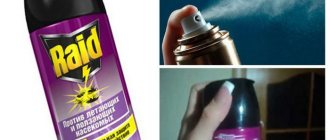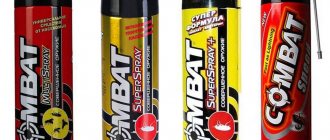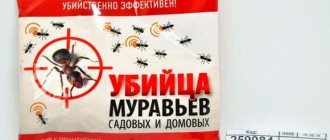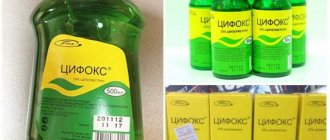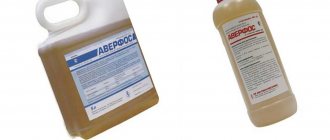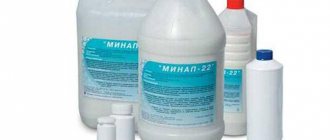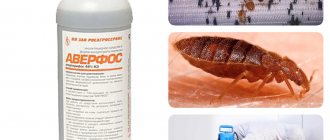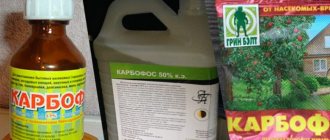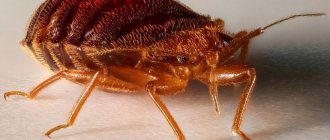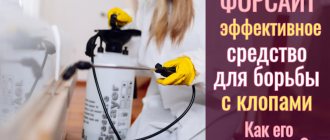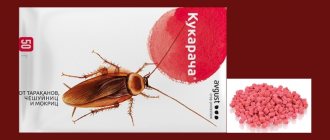Most people associate dichlorvos with a toxic substance that has a strong toxic odor. But everyone knows that aerosols are effective against harmful insects that have settled in the house.
Dichlorvos for bedbugs contains pyrethroids, which quickly destroy parasites by disrupting the activity of the nervous and respiratory systems of bloodsuckers.
These components are practically safe for the human body. In addition, the new products do not have a pronounced unpleasant odor, are accessible, affordable and easy to use.
Product effectiveness
People who have insects in their home want to know whether dichlorvos helps against bedbugs. The drug contains a number of chemicals that lead to the death of parasites.
But the aerosol only destroys pests that come into contact with insecticide drops. And most bloodsuckers that are not exposed to the poisonous solution often survive.
Is it possible to poison bedbugs with dichlorvos if there are a large number of bedbugs living in the house? If there is an excessive accumulation of insects, it is advisable to carry out comprehensive disinfestation, and the use of a single aerosol will not be effective.
To enhance the effect of the insecticide, it is recommended to spray it on sofas, walls, beds, that is, any nests of bedbugs. The spray does not leave marks on furniture. Its components are absorbed into soft surfaces, which is a good prevention against bloodsuckers.
So, answering the question of whether dichlorvos kills bedbugs, experts note that the insecticide does destroy pests, but only those that have had direct contact with the active components of the product.
The most effective treatment for bedbugs is considered to be comprehensive disinfestation, in which an aerosol is sprayed onto areas of maximum accumulation of parasites. And cracks, window sills and other insect habitats are treated with other potent preparations, for example, liquid concentrates or powders.
How to get rid of odors easier when disinsection
If you order pest control services from a professional sanitary service, discuss this point when ordering. They will select products that smell less and disappear faster.
If you decide to get rid of bedbugs yourself, choose insecticides that:
- effective against resistant insect populations, that is, they will help destroy them in one application and will not require repeated applications in high concentrations;
- made by a manufacturer you can trust and have a good reputation;
- have detailed instructions for use;
- do not have a very pungent odor;
- easy to use.
These are the products that Medilis offers. For example, Superpower spray against bedbugs is effective in combating parasites, but disappears quite quickly and is non-toxic. It is not used, like all other chemical insecticides, to treat bedding or clothing. But it is convenient to spray on any hard surface. The product does not require dilution with water to a working solution; it is produced in easy-to-use packaging - 250 ml bottles with a sprayer. The product is suitable for everyday use by the general public.
If you follow the instructions for use and after wet cleaning and ventilation, there will be no trace of bedbugs left in the apartment, and there will definitely be no unpleasant odors.
Composition and main properties
Dichlorvos is an insecticide produced as an aerosol placed in a can. Most modern antiparasitic sprays differ in composition from those previously produced under the name “dichlorvos”.
The main component of the insecticide is dimethyldichlorovinylphosphate. This is an organophosphorus liquid with a broad spectrum of action.
The new pesticides also contain cypermethrin piperonyl butoxide. The component acts on bloodsuckers contactally, blocking their NS, which causes paralysis and subsequent death of the insect. The advantage of the substance is low toxicity to humans.
To kill bedbugs, other active ingredients are added to the spray:
- hyperonyl butoxide;
- ethanol;
- pyrmethrin;
- aliphatic carbohydrates;
- preservatives.
Thus, bedbugs and dichlorvos are incompatible concepts, because modern insecticides contain pyrethroids.
Plant alkaloids are safe for humans, but harmful to bloodsuckers.
In the human body, pyrethroids break down into safe, non-toxic metabolites. The most toxic component for humans is piperonyl butoxide, which can cause poisoning.
Contraindications and side effects
Dichlorvos poses a danger to human and animal health. The drug contains toxic substances such as:
- piperonyl butoxide,
- cypermethrin,
- permethrin,
- deltamethrin.
Unlike insects, these components in humans, as a rule, cause low-toxic poisoning, but in case of an overdose of vapors or liquids, the victim experiences a general deterioration in health.
Dichlorvos has many contraindications and side effects
Table: stages of poisoning
| Name | When it happens | Symptoms |
| Excitation | About twenty minutes after contact | Dizziness, migraine, agitation, gagging, poor coordination, bronchial cough, constriction of the pupils, sometimes pressure surges, tachycardia |
| Convulsions | A few hours later | General deterioration in health, severe weakness, heavy breathing, convulsions, muscular urge to urinate, faintness, stupor, increased salivation, lack of reaction to light, sometimes heart collapse, problems with the cardiovascular system |
| Paralysis | Further | Loss of consciousness, rapid breathing, lack of response to stimuli |
According to the author of the article, it is possible to avoid serious consequences as a result of dichlorvos poisoning by using alternative methods of pest control, including traditional methods.
Signs of drug poisoning, first aid
If dichlorvos poisoning does occur, it is recommended to do the following:
- The victim is taken out into fresh air.
- Place it in a horizontal position.
- Remove clothing or its elements that restrict breathing.
- The victim's nose and mouth are rinsed with soda solution.
The latter can only be done if the poisoned person is conscious. Under no circumstances should an unconscious person be given ammonia to sniff. After providing first aid, the victim should be taken to the nearest hospital department. If a person is unconscious, call an ambulance.
If the substance gets on the skin, wash the affected areas with plenty of water or a weak soda solution, and apply a sterile bandage. If the person has not lost consciousness, it is advisable to do gastric lavage with activated charcoal, since pyrethroids can enter the body through the epithelium.
If there are signs of dichlorvos poisoning, immediately provide first aid to the victim and call an ambulance.
In the case of eyes, the duration of rinsing can reach 20–25 minutes. Soap and other hygiene products should not be used. After assistance is provided, a sterile bandage is applied to the eyes, and the victim is taken to the hospital.
If the product is swallowed, it is forbidden to induce vomiting, use a laxative to cleanse the intestines, or give the person drink soda. It is important to deliver the victim to a medical center in a timely manner, where, most likely, he will be prescribed inpatient treatment.
Operating principle
Dichlorvos is effective against bedbugs due to the chemical composition of the spray. Modern insecticides contain pyrethroid substances that block the nervous system of bloodsuckers.
Exterminators know how the aerosol works. Experts note that dichlorvos disrupts the functioning of the organs and systems of bedbugs. This causes the death of the parasites.
Modern aerosols have a complex effect. In addition to affecting the nervous system, the components of the products upset the functioning of the respiratory and digestive systems. Chemical components enter the bodies of bedbugs when insects interact with the places where the spray was sprayed.
Dichlorvos is a potent remedy that retains its effect for more than six months. After all, pyrethroids are unique poisons that have a powerful nerve-paralytic effect.
How does Dichlorvos act on cockroaches?
Pyrethroids, which are part of all modern “Dichlorophosoph”, have a nerve-paralytic effect when they enter the body of cockroaches through breathing or with food. They seriously affect nerve endings and provoke irreversible disorders in the central nervous system of insects, causing disruptions in the transmission of impulses. This subsequently leads to suffocation, fatal paralysis and death of the pest.
Varieties of dichlorvos
Many companies make bedbug killers. Moreover, insecticides have different names, compositions and smells.
Often the active ingredients of the drugs are identical, but their additional composition may differ. Modern odorless dichlorvos for bedbugs is a poisonous agent, which should be taken into account when using it and safety precautions must be observed.
To understand which dichlorvos is better, you need to consider each popular aerosol separately. Common sprays for bedbugs are Eco, Neo, Varan, Triple Strike.
Dichlorvos eco
The insecticide is produced by the Russian company Arnest. The composition of the drug is pyrethroids of synthetic origin and an extract from Dalmatian chamomile.
Eco is effective if there are bed bugs in the house. The product has a lavender scent that has a repellent effect.
Is it possible to remove bedbugs with dichlorvos eco?
Reviews from most people using the drug demonstrate that it quickly destroys adult bloodsuckers.
A cylinder with a volume of 190 cm costs about 100 rubles. Despite the availability and effectiveness of Eco spray, it is worth remembering that it is flammable and toxic.
Dichlorvos neo
The spray was developed by Arnest. Neo for bedbugs has almost no odor, so it is ideal for treating rooms where allergy sufferers, children, and pets are often present.
To understand whether bedbugs are afraid of this type of insecticide, it is necessary to consider its composition. In addition to pyrethroids, dichlorvos Neo contains organophosphorus substances and a synergist, which improves the penetration of poison through the hard shell of bedbugs.
The effect of the aerosol is observed for another 2 weeks after its use. A can of Neo, volume 190 ml, costs from 62 rubles.
Dichlorvos monitor lizard
This type of insecticide is available in several forms - Varan Forte, Aetiklop and Universal. The products help well against bed bugs, and their antiparasitic effect lasts up to 23 days.
Varan is produced by the Novosibirsk company Sibiar. It is advisable to poison with the drug the areas of maximum accumulation of bedbugs - a sofa, a bed, an armchair.
Varan has a powerful effect. The spray has a pleasant lemon scent. The cost of an aerosol is from 120 rubles.
Dichlorvos triple strike
Destruction of bedbugs in an apartment requires the use of potent toxic agents. Triple Impact, produced by Domovoy Proshka, is considered an effective insecticide.
But is it possible to get rid of bedbugs using this aerosol? The spray contains tetramethrin, cypermethrin, a synergist, which makes it a powerful insecticide that destroys parasites after the first treatment.
The advantages of the drug are convenient use and relative harmlessness to humans. Disadvantages - dichlorvos has a strong unpleasant odor.
After spraying the aerosol, the death of bedbugs occurs within 6 minutes. The effect lasts up to 14 days.
A cylinder containing 200 ml of a chemical solution costs about 140 rubles.
Stages of dichlorvos poisoning
Intoxication with dichlorvos goes through three stages. Each of them is characterized by the presence of certain symptoms.
Stages:
- Increased arousal. A similar period develops a few minutes after poisoning. The stage is characterized by a lack of control over movements, severe drooling, dizziness, and migraine pain is diagnosed. At the first stage, the victim’s blood pressure increases and the heartbeat increases.
- After a few hours, the victim begins the stage of loss of coordination. There is a general deterioration in the condition, the separation of urine and feces is accompanied by pain. During this period, coordination and visual functions are impaired. A person is diagnosed with trembling limbs and convulsions. In the absence of help, loss of consciousness, stupor, pulmonary edema occurs, and death is possible.
- Paralytic stage. The most difficult stage. Characterized by lack of consciousness, paralysis, decreased blood pressure, and the heartbeat becomes rare. In the absence of help, death occurs a day after poisoning.
We recommend: Exogenous intoxication and poisoning of the body
Poisoning in children develops faster than in adults due to their fragile bodies.
Instructions for use
Before treating a room with an insecticide, you should be properly prepared. All rooms need to be dusted and then ventilated. You need to remove the curtains from the windows and hide all the food in the refrigerator or cabinets.
It is necessary to free up hard-to-reach places. Windows and ventilation ducts must be closed. All people and animals should be removed from all rooms.
How to use dichlorvos? The can must be shaken several times. Then the stream is directed to places where bedbugs accumulate, holding the bottle as far as possible from the face.
The following areas must be treated with the spray:
- furniture;
- bin;
- cabinets;
- baseboards;
- window sills;
- corners;
- carpets;
- paintings;
- shells;
- floor.
How to get rid of bedbugs with dichlorvos so as not to harm your health? After spraying the spray, you should leave the room for at least 30 minutes.
It is better to enter the room when the smell has completely disappeared.
After treatment, you need to ventilate the room for 60 minutes. Then you should do a wet cleaning of your home. Clothes and bedding should be washed in very hot water.
First aid and treatment of poisoning
In case of poisoning with such a substance, first aid at home must be provided as quickly as possible.
This will help avoid unpleasant consequences and serious changes in the functioning of organs. First of all, a medical team is called. Before their arrival, it is allowed to carry out activities to alleviate the patient’s condition.
Activity:
- In case of poisoning by dichlorvos vapors, the victim is provided with access to fresh air, taken outside, and loosened from tight clothing.
- The oral cavity is washed with plenty of clean water.
- If the toxin gets on the skin, wash it with soap and water. The procedure should be gentle, without strong pressure.
- Infection of the eyes with dichlorvos requires rinsing with water or a weak solution of soda (a teaspoon per glass of water).
- If poisoning has developed as a result of ingestion of a poisonous drug, then the victim’s stomach must be thoroughly rinsed. After cleaning, it is recommended to take sorbent.
- The patient is given a lot of clean water to drink to reduce the concentration of the toxic substance.
- Before the doctors arrive, the victim is put to bed and given rest.
The first aid provider must follow safety precautions and remember that dichlorvos is well absorbed through the skin. Correctly carried out measures increase the chances of a quick recovery.
Poisoning in any form requires contacting a medical facility. After carrying out the necessary diagnostics, the specialist will select the appropriate treatment option.
Therapy:
- Gastric lavage
- Administration of anticonvulsants
- The use of atropine as an antidote,
- Prescription of drugs that normalize the activity of the heart muscle and other organs,
- For breathing problems, artificial ventilation is used.
Treatment includes following a diet and taking vitamin complexes. The duration of therapy depends on the patient's condition and the degree of poisoning.
Precautionary measures
Despite the fact that modern dichlorvos for bedbugs are less toxic than their predecessors, it is important to adhere to safety rules when using them. It is advisable to treat the apartment in a special suit, gloves, respirator, and goggles. This will provide protection to the skin and mucous membranes, which can cause burns and allergic reactions if poison comes into contact.
Other precautions:
- During disinfestation, the can must be kept at a distance of half a meter from the face.
- Do not spray near heating devices or open flames.
- You cannot stay in the treated room for a long time and immediately after applying the insecticide against blood-sucking insects, you must immediately leave the room.
- After disinfestation, you should thoroughly wash your face and hands.
- After 2-4 hours after applying the poison, you should wipe all surfaces in the house with a damp sponge.
Causes and symptoms of poisoning
Why is dichlorvos intoxication possible? There are several factors that can provoke such poisoning.
We recommend: Corpse poison - consequences and signs of poisoning
Factors:
- Use in areas with poor ventilation and without appropriate protective equipment,
- Ingestion or injection into the subcutaneous layers for the purpose of suicide,
- Poisoning in children occurs due to negligence,
- The presence of a child, an pregnant woman, or an elderly person during the treatment of the premises.
There are several methods of poisoning: inhalation of vapors, ingestion, contact with the skin. With any of the methods, the respiratory process may be impaired. If dichlorvos enters the bloodstream immediately, after some time a malfunction in the functionality of the liver is diagnosed.
In some cases, there is a sharp disruption of the nervous system. Symptoms of dichlorvos poisoning appear after a short period of time.
Signs:
- Headache,
- Swelling of the mucous membranes of the sinuses,
- Runny nose,
- Head spinning
- Increased body temperature
- Loss of coordination
- Severe nausea and vomiting
- intestinal disorder,
- Visual impairment
- Breathing problems, asthma attacks,
- Increased sweating
- Convulsive manifestations.
Upon contact with the skin, a person is diagnosed with allergic manifestations, itching and burning sensation, and irritation. If dichlorvos gets into the eyes, pain, redness, and intense production of tears are noted.
A person’s condition deteriorates quite quickly, this is especially noticeable if poisoning occurred as a result of ingesting dichlorvos.
Description of the drug
The earlier version of Dichlorvos was more toxic. The composition included a substance from a group of organophosphorus compounds called dimethyl-dichlorovinylphosphate. It is distinguished by its aggressive effect on the human body. For this reason, Dichlorvos was no longer used. For marketing purposes, the name of the product has not been changed. The modern version of the drug contains various pyrethroids. This is a multi-component product, due to which it has an effect on different insects. There is no risk of harm to humans (provided the instructions for use are followed).
Chemical composition
Dichlorvos Neo, Varan and other varieties differ in composition. At the same time, the minor components differ, in most cases the active substances are the same:
- cypermethrin is a second generation pyrethroid, the substance has a mild odor, is poorly soluble in water, which should be taken into account when using Dichlorvos against cockroaches and other insects, there are different types of this substance, they differ in isomeric composition (alpha-cypermethrin, beta-cypermethrin, etc.). d.),
- tetramethrin is another insecticide of the pyrethroid class; when treating a room, the destruction of insects occurs under direct contact; this substance does not withstand the influence of solar radiation and begins to deteriorate,
- permethrin is a type of pyrethroid, it is a direct analogue of the natural insecticide pyrethrum, this substance can be used to treat ectoparasites,
- piperonyl butoxide is an auxiliary component of insecticide-based preparations; the substance enhances the effect of the toxic components listed above; its function is to inhibit the mechanisms in the body of insects that are aimed at destroying pyrethroids.
Additionally, the drug contains components that do not exhibit insecticidal activity: ethyl alcohol, fragrances, preservatives, stabilizers.
How does Dichlorvos work?
The principle of operation of the drug is based on the properties of various insecticides. For this reason, the level of effectiveness and mechanism of action of different types of products differs. Cypermethrin is a contact substance. This means that this compound provokes the rapid death of pests, but provided that this component gets on the chitinous covers of insects. This disrupts the functioning of the nervous system. The pests gradually lose their motor activity, resulting in paralysis and death soon after.
Cypermethrin is resistant to ultraviolet radiation. In comparison, tetramethrin breaks down in the sun. However, this substance retains its properties when heated. Tetramethrin enters the pest's body through inhalation, along with food. The mechanism of action is similar to how cypermethrin works. This similarity is due to the fact that these substances belong to the same group of insecticides.
Permethrin destroys the nervous system of parasites. This substance most effectively eliminates ectoparasites (insects that live on the human body), however, as part of Dichlorvos, it is used less frequently for treatment against lice and ticks. Piperonyl butoxide enhances the effect of insecticides.
Pros and cons of the product
Positive traits:
- speed of action, which is due to the release form (produced in the form of an aerosol),
- complex effect on pests: insecticides can enter the body of insects through inhalation, along with food and through direct contact - through chitinous covers,
- moderately aggressive effect on humans; in comparison, dimethyl dichlorovinyl phosphate is more toxic and may pose a health hazard,
- the components in the product decompose at the end of their service life, without generating toxic waste, which makes the product safer for the environment,
- it is permissible to use the product near plants without harm to them,
- Dichlorvos is an innovative, universal drug that helps destroy various pests,
- long period of action of active components: insecticides remain on surfaces after treatment of the room for 1 month.
Minuses:
- the product takes a long time to dissipate,
- treatment must be carried out several times to get rid of insects.
Historical reference
Dichlorvos
In the mid-20th century, specialists from the German concern Bayer developed an insecticide in the form of a spray. Soviet scientists proposed their development - dimethyl dichlorovinyl phosphate. The packaging was borrowed from the Germans. The drug was named "Dichlorvos".
The question of where to buy dichlorvos did not even arise for Soviet people. The product was sold in all hardware stores throughout the USSR.

